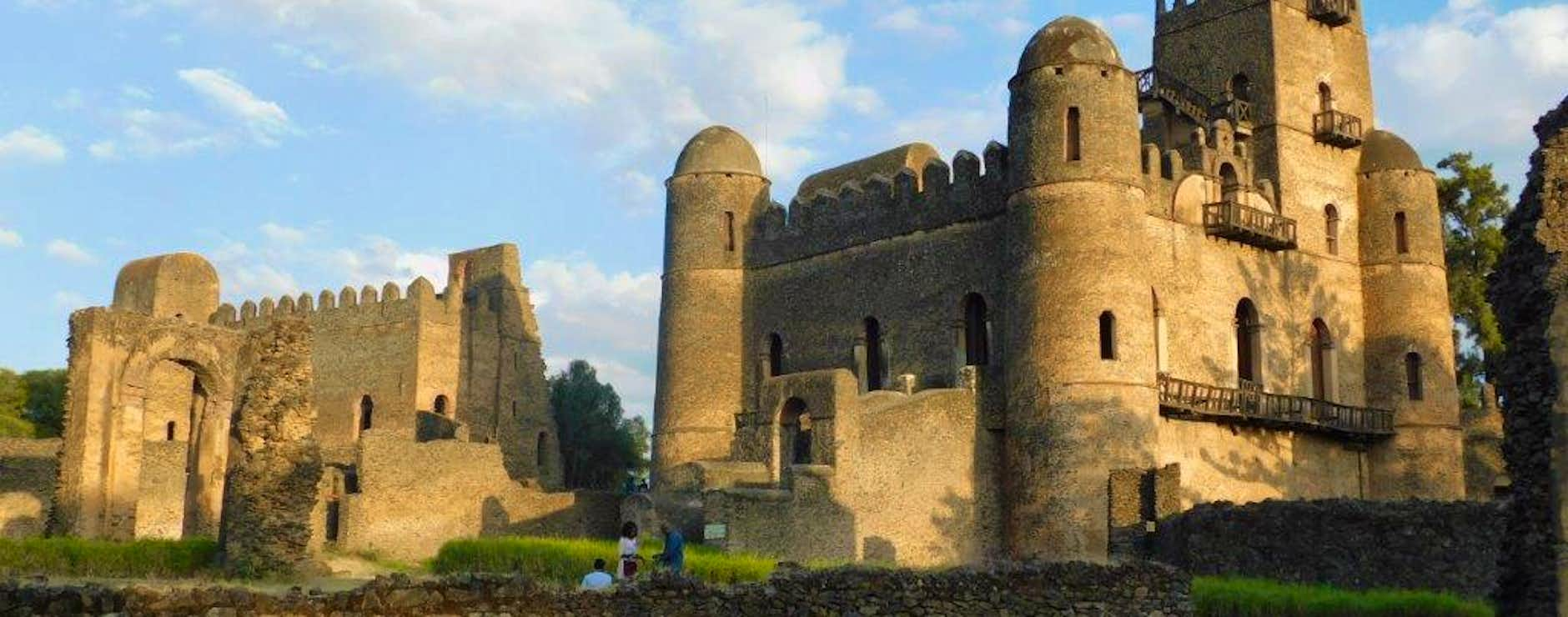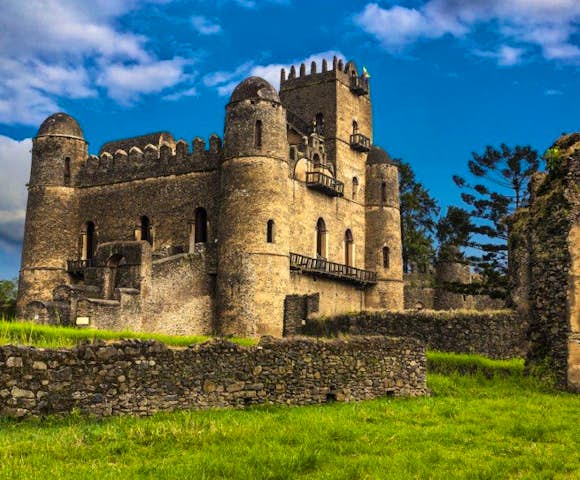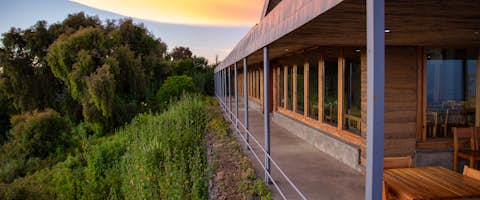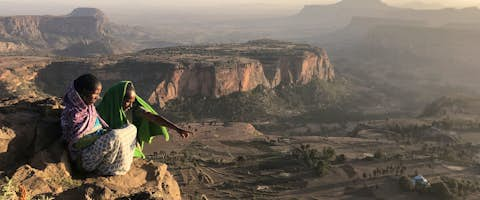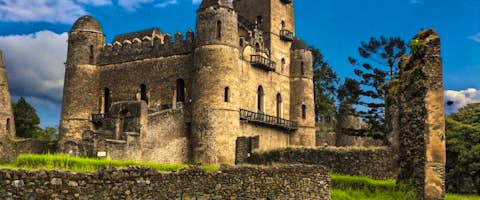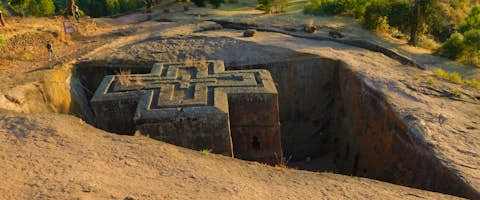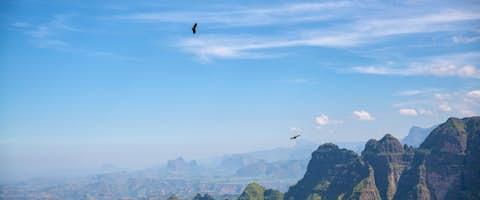History of Fasil Ghebbi
Atop lush grasses and surrounded by trees, Fasil Ghebbi served as the royal residence for the rulers of Ethiopia from the 1640s to 1864, and remains a site of significant cultural and historic importance in the country.
Also known as the Royal Enclosure, Fasil Ghebbi is a UNESCO World Heritage Site. It was built by Emperor Fasiladas who, after growing bored with the migratory semi-nomadic lifestyle of his predecessors, decided to make a statement by building a grandiose palace complex - one of the most magnificent structures of its time.
Surrounded by a 900-metre wall, the Royal Enclosure houses a series of churches, palaces and monasteries, each with their own architectural style.
Many of the early buildings have strong Hindu and Arabic influences, with subsequent occupiers adding their own touches on the pre-existing buildings. Portuguese, Moorish and Aksumite influences are seen in the later additions.
No one knows for sure why this area was chosen as the capital of Ethiopia, however it prophesied that an Ethiopian capital would be built at a place with a name that began with the letter G. The legend led to a whole series of 16th- and 17th-century towns: Guzara, Gorgora, and finally Gondar.
Another legend claims that the city was built in a place chosen by God, who pointed it out to Fasilidas who had followed a buffalo there when hunting.

Castles in the Royal Enclosure
Enqualal Gemb
Perhaps the oldest building on site, Enqualal Gemb - also known as the Egg Castle on account of its egg-shaped dome roof - was built by Emperor Fasilidas and is one of the most famous structures in the compound.
Towering above Enqualal Gemb lies the Fasiladas prayer room, which has 360 degree views around Gondar.
From the 2nd-floor bathroom, beyond the prayer rooms lies an unguarded watchtower overrun with vines. The tower offers some of the best views across the ancient city, and some say on clear days you can see as far as Lake Tana!

Palace of Iyasu
To the northeast of the complex lies the Palace of Iyasu - the first to be built in the area.
The palace was built during the reign of Iysau I (1682-1706), who was considered the greatest ruler of the Gonderine period. Iyasu Palace is renowned for its saddle shape and unusual vaulted ceilings, and was once adorned with shimmering Venetian glassware and decadent gold-plated ivory artwork.
At its time, the complex was viewed as one of the most majestic castles and remains an impressive sight to this day, although the palace has seen its fair share of destruction. An earthquake in 1704 caused significant aesthetic damage, and a British bombing campaign is thought to have caused the bulk of the structural damage and reduced much of this once lavish structure to rubble.
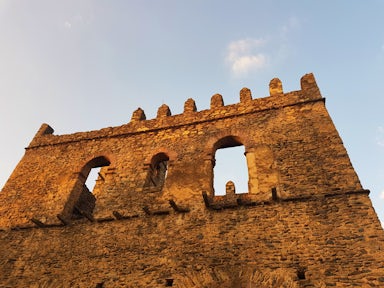
Banquet Hall & Granary
North of Iysau's Palace is the banquet hall and granary. To the west of this you'll find a rectangular library, built for Yohannes I during the reign of his father, Fasilidas.
The building was once beautifully covered in detailed artwork, but was unfortunately covered with plaster during the Italian occupation of Ethiopia.
The Fasilidas archive lies northwest of the library, and was once plated in the same decadent laced gold and ivory artwork that was found inside the main building.
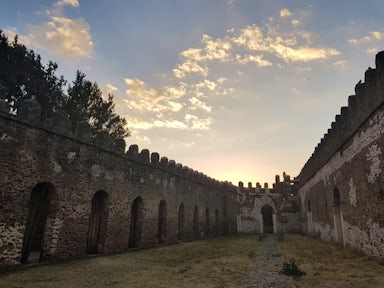
Dawit's Hall
Venturing further north, past the archives and library you'll find the vestiges of Dawit's Hall, known as the House of Song.
Dawit's Hall is a huge banquet hall that held host to a range of lavish secular ceremonies and exuberant festivities. Built by Emperor Dawit, who also built the first two Lion Houses found on site, the building was later updated by Dawit’s successor, Emperor Bakaffa, and the Italian occupiers.

Mentewab’s Castle & Atatami Mikael
Emperor Bakaffa is also responsible for the last palace on site, Mentewab’s Castle, a two-storey castle that now serves as the site office.
The last stop on our tour, found just outside the Royal Enclosure’s northern gate is Atatami Mikael church.
The church itself is off limits to tourists, however the museum that lies next to the church houses an array of ancient artefacts and magnificent manuscripts, detailing the daily lives of those who lived and worked within these walls.

Fasil Ghebbi FAQs
-
Fasil Ghebbi Opening Hours
The Fasil Ghebbi opening hours are 8:30-17:30 Monday through Sunday.
-
How long does it take to visit the Castles?
The Royal Enclosure can be explored in a morning or afternoon. It is often included as part of a wider city tour of Gondar, but takes centre stage as the main attraction in the city.
-
Do I need a guide to visit Fasil Ghebbi?
A tour guide is strongly advised.
The site is one of significant historical value and having a tour guide allows you to get the most from this experience. While not mandatory, exploring the compound without a guide means you get none of the historical context and insight a guide can bring.
For historical sites like Fasil Ghebbi, a guide is essential.
If you are booking with Brilliant, a guide is included in your trip as standard.
-
What else is there to see in Gondar?
Beyond the Royal Enclosure, the main attractions in Gondar are the Debre Birhan Selassie church and Fasilides' Bath.
Most visitors passing through Gondar will also head up into the Simien Mountains National Park.
Ready to explore Fasil Ghebbi?
Ready to plan your Ethiopia adventure?
Listen
We'll spend some time listening to your aspirations, then discuss the kind of experience that might suit you.
Match
Next we'll discuss the options, shortlist the best trips for you and present you our impartial recommendations.
Reserve
We'll place a 24 hour hold on your preferred option - without obligation - whilst we talk through the details.
Whatever your budget, group size, length of stay, preferred activity or appetite for adventure, we can help.
+1 315 645 2889

